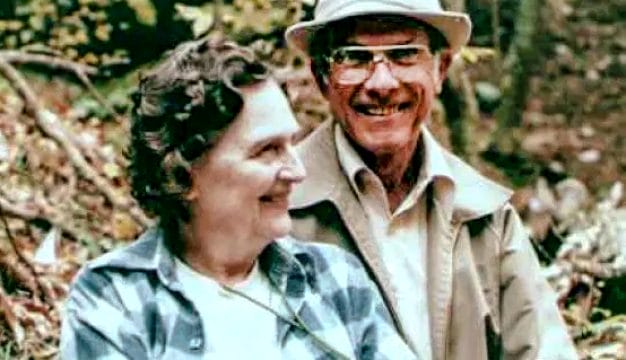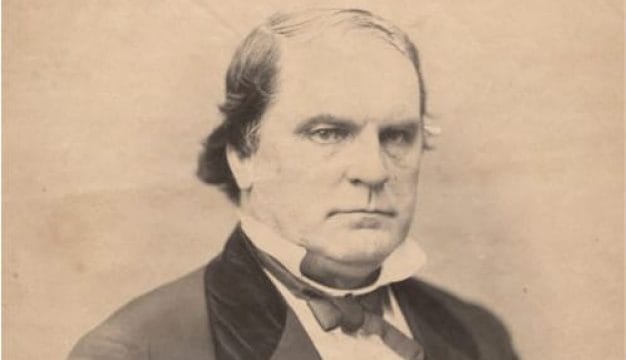Paleoindian Period
 Dalton Projectile Points
The Paleoindian period (approximately 15,000 to 10,500 years before the present) encompasses the era when the first people arrived in the Americas. Because there is little surviving evidence from this period, modern archaeologists have great difficulty in reconstructing what life was like for these first inhabitants. Despite careful excavation of archaeological sites and recovery of artifacts ranging from stone tools to projectile points, scholars can make few absolute statements about Paleoindian culture and everyday life. This is in part due to the forces of nature, which cause organic artifacts to deteriorate quickly in Alabama‘s acidic soil. Thus, archaeologists are left with stone tools as their main clues to Native American life during the Paleoindian period. Interestingly, some of the highest densities of the distinctive stone tools made by Paleoindians have been found in north Alabama, and these tools are present generally across the state. Detailed study of these tools and diligent searches for traces of Paleoindian occupation sites have produced interesting hypotheses and many more questions about how these ancient people adapted to what was a strange and often hostile new environment.
Dalton Projectile Points
The Paleoindian period (approximately 15,000 to 10,500 years before the present) encompasses the era when the first people arrived in the Americas. Because there is little surviving evidence from this period, modern archaeologists have great difficulty in reconstructing what life was like for these first inhabitants. Despite careful excavation of archaeological sites and recovery of artifacts ranging from stone tools to projectile points, scholars can make few absolute statements about Paleoindian culture and everyday life. This is in part due to the forces of nature, which cause organic artifacts to deteriorate quickly in Alabama‘s acidic soil. Thus, archaeologists are left with stone tools as their main clues to Native American life during the Paleoindian period. Interestingly, some of the highest densities of the distinctive stone tools made by Paleoindians have been found in north Alabama, and these tools are present generally across the state. Detailed study of these tools and diligent searches for traces of Paleoindian occupation sites have produced interesting hypotheses and many more questions about how these ancient people adapted to what was a strange and often hostile new environment.
Populating the Americas
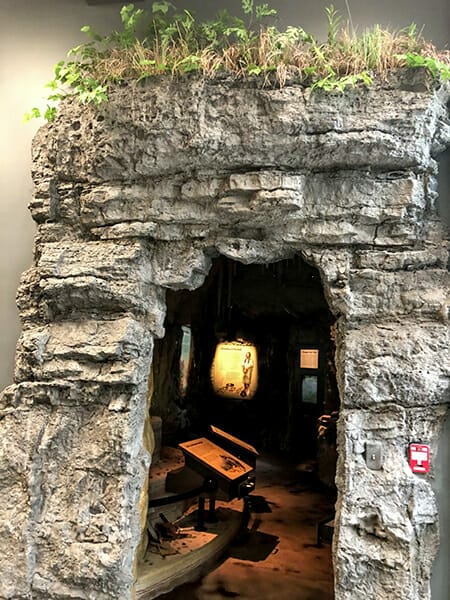 Dust Cave Exhibit Entrance
Although there is continuing debate about when people first arrived in the Americas, most scholars date the beginning of the Paleoindian period to about 15,000 years before the present. This places the initial human migrations at the end of the Pleistocene epoch, also known as the Ice Age. There is also some debate among researchers about where these people originated, but much of the linguistic, archaeological, and genetic evidence supports the hypothesis that the first inhabitants were from Asia. Presumably these people came across the Bering land bridge, which once connected present-day Alaska and Siberia. At the time, a great quantity of the world’s water was trapped in glaciers and the land area of the continents was significantly greater than it is today. These people most probably migrated further and further south, east, and west along the major river valleys in the Americas. Habitation of the southeastern United States by Paleoindian peoples is generally dated to around 11,500 years ago.
Dust Cave Exhibit Entrance
Although there is continuing debate about when people first arrived in the Americas, most scholars date the beginning of the Paleoindian period to about 15,000 years before the present. This places the initial human migrations at the end of the Pleistocene epoch, also known as the Ice Age. There is also some debate among researchers about where these people originated, but much of the linguistic, archaeological, and genetic evidence supports the hypothesis that the first inhabitants were from Asia. Presumably these people came across the Bering land bridge, which once connected present-day Alaska and Siberia. At the time, a great quantity of the world’s water was trapped in glaciers and the land area of the continents was significantly greater than it is today. These people most probably migrated further and further south, east, and west along the major river valleys in the Americas. Habitation of the southeastern United States by Paleoindian peoples is generally dated to around 11,500 years ago.
What is now the southeastern United States would be unrecognizable to its present-day inhabitants. Average temperatures in the Southeast were likely more similar to those in present-day Minnesota, there was less seasonal variation, and the coastline would have extended far out into the Gulf of Mexico as a result of the lower sea levels. Some of the plants and animals would have been familiar, but the plant species that existed in the Southeast at the time are now found in the northernmost portions of the continent, and some of the animals are now extinct. During the last stages of the Ice Age, what is now Alabama consisted of two very different environments, with the general dividing line running east-west through present-day Montevallo. The northern portion was rapidly changing from a coniferous forest interspersed with open meadows to a dense oak-hickory forest. The southern portion of the state was already dominated by an existing oak-hickory forest. These environments provided different resources and foods for the first inhabitants, and these opportunities would change, in the short term, from year to year and, in the long term, over their lifetimes.
Many of the animal species roaming the Ice Age landscape were mammals that are among the largest that have ever lived and are thus referred to as megafauna. Many of these now-extinct animals were hunted by Paleoindians, including the mastodon, giant bison, mammoth, and giant ground sloth. Some scholars believe that overhunting by Paleoindians led to the extinction of the megafauna, but this hypothesis is still open to debate, given the scant evidence of Paleoindian ways of life. Research indicates that some small animal and bird species also went extinct at about the same time, which points to alternative hypotheses such as the changing environment and disease. In addition, Paleoindians in Alabama hunted a variety of mammal species, including the white-tailed deer and rabbits, that still live in Alabama today.
Paleoindian Life
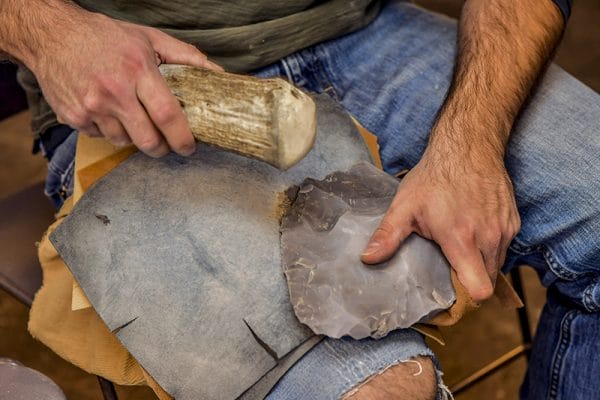 Flintknapping
The mystery surrounding the origins of the peoples who first inhabited the Americas derives from the fact that so little evidence has been found from which to make inferences about their way of life. The most common Paleoindian artifacts found throughout the United States are finely crafted, distinctively fluted stone spear points, and even these are rare finds. Prehistoric peoples around the world made tools from rock types that were carefully selected for their fracture characteristics and their ability to be shaped in a controlled manner. Archaeologists refer to the manufacture of stone arrowheads, spear points, and knives as flintknapping. The name derives from a type of sedimentary rock called flint in Europe and chert in the Americas that is extremely fine grained and that fractures in a clean and predictable manner. A skilled flintknapper would remove flakes (broad, flat pieces of chert struck from a larger parent piece) similar to the way a sculptor creates a stone statue. The appropriate shape is achieved by repeatedly removing flakes with another rock or a piece of antler. Modern archaeologists experimenting with flintknapping have found that by changing the striking tool, the angle of the strike, and the amount of force used, Paleoindians could have produced tools of different sizes and shapes in short order. Flakes were sometimes used as tools themselves, with little extra working, because they usually had a sharp cutting edge. If they could not be worked, they were simply discarded. Paleoindian stone tool technology includes distinct scrapers for processing hides as well as evidence of a blade technology. Archaeologists who study stone tools use the term “blade” to describe a flake that is twice as long as it is wide. Such tools are created from carefully prepared parent pieces. Blade technology can be compared with a modern assembly line in that it produced flakes of generally the same size and shape until the parent piece was used up. Blades were then used as the basis of a variety of other stone tools, including scrapers. Undoubtedly, Paleoindians used a wide variety of other raw materials for tools, such as wood, bone, and antler, but these rarely survive in the archaeological record.
Flintknapping
The mystery surrounding the origins of the peoples who first inhabited the Americas derives from the fact that so little evidence has been found from which to make inferences about their way of life. The most common Paleoindian artifacts found throughout the United States are finely crafted, distinctively fluted stone spear points, and even these are rare finds. Prehistoric peoples around the world made tools from rock types that were carefully selected for their fracture characteristics and their ability to be shaped in a controlled manner. Archaeologists refer to the manufacture of stone arrowheads, spear points, and knives as flintknapping. The name derives from a type of sedimentary rock called flint in Europe and chert in the Americas that is extremely fine grained and that fractures in a clean and predictable manner. A skilled flintknapper would remove flakes (broad, flat pieces of chert struck from a larger parent piece) similar to the way a sculptor creates a stone statue. The appropriate shape is achieved by repeatedly removing flakes with another rock or a piece of antler. Modern archaeologists experimenting with flintknapping have found that by changing the striking tool, the angle of the strike, and the amount of force used, Paleoindians could have produced tools of different sizes and shapes in short order. Flakes were sometimes used as tools themselves, with little extra working, because they usually had a sharp cutting edge. If they could not be worked, they were simply discarded. Paleoindian stone tool technology includes distinct scrapers for processing hides as well as evidence of a blade technology. Archaeologists who study stone tools use the term “blade” to describe a flake that is twice as long as it is wide. Such tools are created from carefully prepared parent pieces. Blade technology can be compared with a modern assembly line in that it produced flakes of generally the same size and shape until the parent piece was used up. Blades were then used as the basis of a variety of other stone tools, including scrapers. Undoubtedly, Paleoindians used a wide variety of other raw materials for tools, such as wood, bone, and antler, but these rarely survive in the archaeological record.
Armed only with stone tools in a harsh environment, how did Paleoindians make a living in the Southeast during the Ice Age? Scientists have established that Paleoindians were not farmers because there is no evidence of domesticated plants or farm animals from that time. Given that the few domestic dog bones in the Americas have been shown to be related to those from Asia, it is likely that Paleoindian people brought domesticated dogs with them. Paleoindians lived off what the land provided in what anthropologists call a hunting and gathering way of life. Several hunter-gatherer societies exist today in the world, and anthropologists have worked with them for more than 100 years and gained some understanding about how they live in different environments. Archaeologists use information about these modern peoples to help them develop hypotheses about what life was like in the past. Because archaeologists only have access to artifacts, they must use other ways to reconstruct the behaviors and activities of people who lived thousands of years ago. Experiments and study of living peoples are two ways of doing this. It is important to keep in mind, however, that modern hunter-gatherers are not “primitive” peoples, but that they help provide guidance for determining how prehistoric hunter-gatherers lived than do agriculturalists because hunter-gatherers from any era of human history likely solve basic problems of living in similar ways.
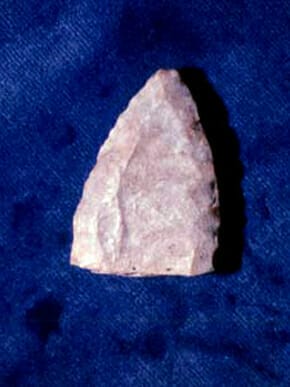 Cumberland Projectile Point
Although little has survived of the Paleoindian way of life, diligent investigations have allowed archaeologists to say with some certainty what these early people did not have, and this includes pottery, substantial built structures, and domesticated plants or farm animals. Rather, life for Paleoindians as commonly reconstructed by archaeologists likely revolved around an extended family or small group of families of between 25 and 50 people (a social structure known as a band) who travelled long distances across a landscape generally devoid of other people in their search for food. Hunting is generally emphasized in discussions of Paleoindian lifeways, but a focus on megafauna may or may not be accurate. The climate during the Ice Age supported fewer wild plants than today, but the Paleoindian diet was certainly more diverse than a nightly meal of mammoth. Paleoindians, especially in the southeastern United States, probably took advantage of a range of food resources, including big game when the opportunity presented itself.
Cumberland Projectile Point
Although little has survived of the Paleoindian way of life, diligent investigations have allowed archaeologists to say with some certainty what these early people did not have, and this includes pottery, substantial built structures, and domesticated plants or farm animals. Rather, life for Paleoindians as commonly reconstructed by archaeologists likely revolved around an extended family or small group of families of between 25 and 50 people (a social structure known as a band) who travelled long distances across a landscape generally devoid of other people in their search for food. Hunting is generally emphasized in discussions of Paleoindian lifeways, but a focus on megafauna may or may not be accurate. The climate during the Ice Age supported fewer wild plants than today, but the Paleoindian diet was certainly more diverse than a nightly meal of mammoth. Paleoindians, especially in the southeastern United States, probably took advantage of a range of food resources, including big game when the opportunity presented itself.
Clovis Culture
Archaeologists often divide the Paleoindian period into sub-periods based on types of prehistoric projectile points, but few specifics of prehistoric lifeways are known for the entirety of the period. Clovis is the earliest style of projectile point in North America, with subsequent styles including Cumberland, Redstone, Quad, and Dalton, all of which have similarities to the Clovis type. The earliest artifacts found in the Americas, including Alabama, were made by people from the Clovis culture, which is identified by the distinctively fluted Clovis point. Fluting is the removal of a long thin flake from the base of a finely crafted spear point. A Clovis point is lanceolate in shape and looks something like a flat “rocket” with parallel sides and a fluted, concave base. A typical specimen is approximately 2.5 inches long, 1 inch wide, and one-third of an inch thick. Investigators have found a wide range of Clovis point sizes, including some that are more than 6 inches in length. All prehistoric peoples who manufactured chipped-stone tools relied on materials that would break in a controlled fashion, but Paleoindian peoples relied on particularly high-quality varieties of these materials. Paleoindian flintknappers invested great effort and used considerable skill in manufacturing their stone tools. They began the process with high-quality chert that is often found hundreds of miles from its geologic source, indicating that people probably travelled great distances for good sources of stone. This material aided flintknappers during the fluting process, which if incorrectly carried out would ruin the stone tool at the point when it was almost completed.
The fine detail of these tools and the wide range of lengths suggest that Paleoindian peoples resharpened and reused their tools often and designed them to have a long use-life. Paleoindian people thus created a technology that met the demands of their way of life, which involved moving frequently, often at great distances, in search of food. These travels undoubtedly took them to new places, and they must have realized that they might not have access to the raw materials for manufacturing their tools in these new areas. They therefore designed their tools to be long-lasting, so that they could afford to exploit these new areas without always having to remain close to sources of high-quality stone.
Finely crafted Clovis points were designed to maximize penetration into the prey animal and minimize breakage. The shape of the flute allowed for smooth and efficient attachment to a composite spear, a technology that has also been found in Asia and Europe. The blade was likely first attached to a foreshaft that in turn fit into a long and heavy main shaft. This composite weapon was a sophisticated piece of hunting equipment that was well-suited for killing at close range, whether it was megafauna or smaller mammals.
Numerous Clovis points have been found throughout North America, but few Clovis archaeological sites have been located. Clovis points are typically found lying on the exposed ground, with no other archaeological evidence visible. These isolated finds provide some information about Clovis life, but without carefully excavated archaeological sites, the Clovis people largely remain a mystery. Some scholars believe that present-day north Alabama served as a “staging area” for further Paleoindian migrations because so many Clovis points have been found in the area. Paleoindian peoples who entered north Alabama found an environment rich in resources, and their populations increased, spurring additional migrations.
The Paleoindian period in the southeastern U.S. is marked by changes in stone tool technology over time. Scientists can say little about what prompted these changes, but they may reflect adaptations to changing environments. Some of the stone tool types that succeeded Clovis in Alabama include Redstone, Quad, and Beaver Lake. Their names derive from the locations where large numbers of them were collected. Only Redstone points are regularly fluted, but all of these point types are finely crafted with a distinctive base for attachment to a shaft. Scholars believe that the distributions of specific point types suggest that they may have been local styles specific to the groups of small bands inhabiting territories of approximately 150 to 250 square miles. Little else is known about the lives of these prehistoric peoples, but presumably changes in the climate resulted in a more generalized hunting and gathering life. At some point around 10,500 years ago, people began making styles of projectile points that were so different from those of the Paleoindian period that they could no longer be described as belonging to that period. The environment in the Southeast had changed quite a bit by that time as the Ice Age drew to an end, so archaeologists infer that the way of life for the region’s inhabitants must have changed significantly as well. This new period is known as the Archaic and refers to the time period from about 10,500 years ago until about 3,000 years ago.
Paleoindian Archaeology in Alabama
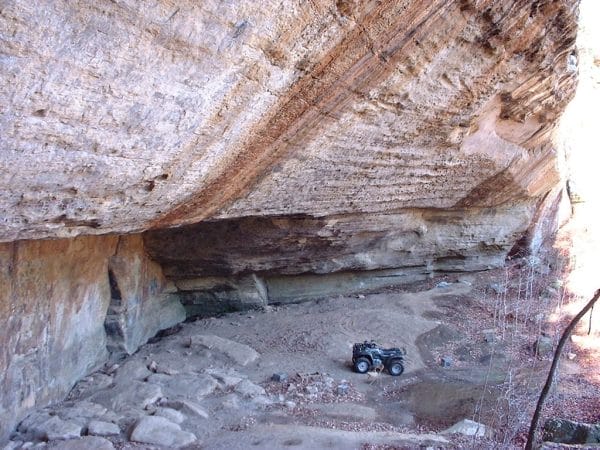 Stanfield-Worley Bluff Shelter
The most extensive research into the Alabama Paleoindian period has been conducted by University of Alabama archaeologist Eugene Futato, who maintains the Alabama Paleoindian Point Survey database and has published a number of articles on Alabama’s Paleoindian cultures. Some of the most important Paleoindian sites in Alabama are the Quad, located on the Tennessee River, which has produced more than 200 fluted points; and Dust Cave, near present-day Florence, which has produced radiocarbon dates and artifacts that date to the end of the Paleoindian period (circa 10,500 years ago), as have materials recovered from the Stanfield-Worley Bluff Shelter site in Colbert County. Some sites that were once thought to include evidence of Paleoindian occupation, such as Russell Cave in Jackson County appear, now to date to the beginnings of the Archaic period. Although information on the Paleoindian peoples of present-day Alabama is scarce, there is great potential for future archaeological investigations of sites in Alabama. Because north Alabama has an unusually high density of these points, many Alabamians with an interest in artifacts and prehistory have been drawn to explore the period. Members of the Alabama Archaeological Society regularly report finds to the state database and publish information on fluted points in the society’s newsletter, raising awareness of and interest in the Paleoindian period in the state. That said, however, archaeological sites are being destroyed at an astonishing rate by both development and looting. For example, the Quad site has largely been eroded away. Research must proceed at a rapid pace if it is to keep up with this destruction.
Stanfield-Worley Bluff Shelter
The most extensive research into the Alabama Paleoindian period has been conducted by University of Alabama archaeologist Eugene Futato, who maintains the Alabama Paleoindian Point Survey database and has published a number of articles on Alabama’s Paleoindian cultures. Some of the most important Paleoindian sites in Alabama are the Quad, located on the Tennessee River, which has produced more than 200 fluted points; and Dust Cave, near present-day Florence, which has produced radiocarbon dates and artifacts that date to the end of the Paleoindian period (circa 10,500 years ago), as have materials recovered from the Stanfield-Worley Bluff Shelter site in Colbert County. Some sites that were once thought to include evidence of Paleoindian occupation, such as Russell Cave in Jackson County appear, now to date to the beginnings of the Archaic period. Although information on the Paleoindian peoples of present-day Alabama is scarce, there is great potential for future archaeological investigations of sites in Alabama. Because north Alabama has an unusually high density of these points, many Alabamians with an interest in artifacts and prehistory have been drawn to explore the period. Members of the Alabama Archaeological Society regularly report finds to the state database and publish information on fluted points in the society’s newsletter, raising awareness of and interest in the Paleoindian period in the state. That said, however, archaeological sites are being destroyed at an astonishing rate by both development and looting. For example, the Quad site has largely been eroded away. Research must proceed at a rapid pace if it is to keep up with this destruction.
The Oakville Indian Mounds Education Center in Danville, Lawrence County, preserves and interprets a Native American mound complex and houses a museum that includes artifacts that date back as far as the Paleoindian Period. The park encompasses approximately 83 acres and features a museum, fishing pond, picnic shelters, walking paths, and other amenities. The Etowah Heritage Museum in Gadsden, Etowah County, the Scottsboro Jackson Heritage Center in Scottsboro, Jackson County, and the Guntersville Museum & Cultural Center in Guntersville, Marshall County, also have artifacts from this period in their collections.
Further Reading
- Anderson, David G., and Kenneth E. Sassaman, eds. The Paleoindian and Early Archaic Southeast. Tuscaloosa: University of Alabama Press, 1996.
- Cambron, James W., and David C. Hulse. Handbook of Alabama Archaeology, Part 1: Point Types. Moundville: Archaeological Research Association of Alabama, 1975.
- Kelly, Robert L., and Lawrence C. Todd. “Coming into the Country: Early Paleoindian Hunting and Mobility.” American Antiquity 53 (April 1988): 231-44.


